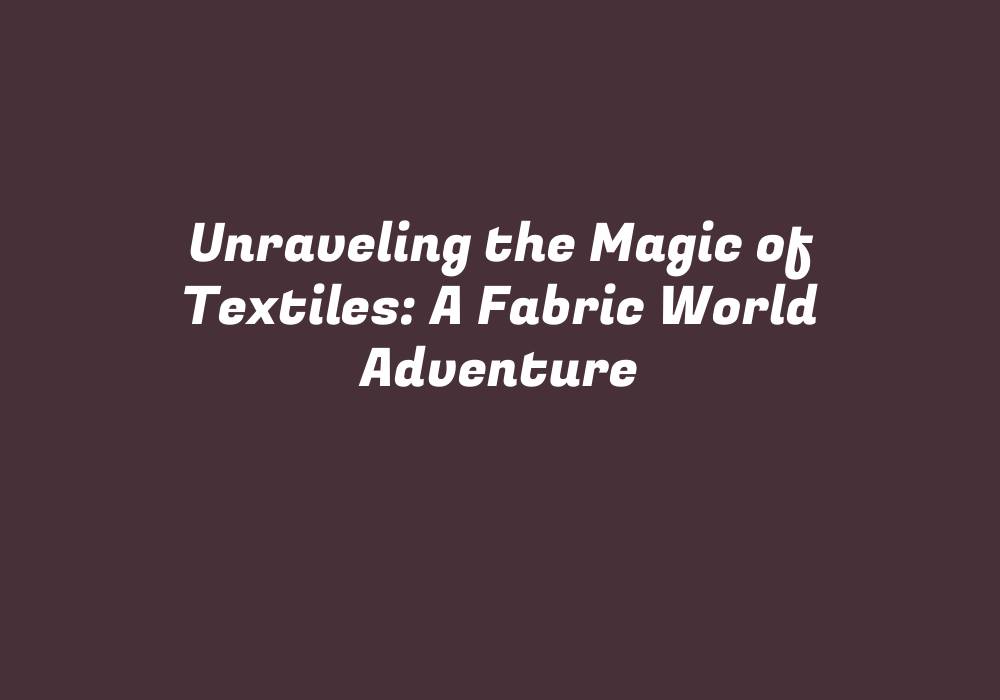Introduction to Textiles: Unraveling the Magic of Fabrics
Fabric is an essential part of our daily lives, playing a major role in clothing production, home furnishing, and artistic expression. From traditional crafts to cutting-edge technology, textiles have undergone many transformations over time. In this article, we will embark on a journey through the world of fabrics to discover their unique qualities, cultural significance, and future possibilities.
Understanding Textiles: A Glimpse into Their Origin and History
Textiles are made from natural or synthetic materials woven together into a flexible material that can be cut, shaped, or tailored into various objects. The history of textile production dates back thousands of years to the dawn of human civilization. From early cotton and linen fabrics in ancient Egypt to silk’s origins in China during the Qin Dynasty (221-206 BCE), textiles have played a vital role in the development of our societies.
Cultural Significance: The Emotional Impact of Textiles
Textiles are not merely functional items but also embody cultural and emotional significance. Fabrics can represent status, traditions, and even identity. For instance, the kimono, a traditional Japanese garment, is highly symbolic as it has been worn by the elite for centuries to demonstrate their refined taste and social standing.
In contrast, the vibrant and intricate designs of African textiles such as the Adinkra symbols from Ghana or Kente cloth from West Africa serve as a visual representation of African heritage and history. These fabrics often carry deep symbolic meanings that transcend the boundaries of mere aesthetics.
Evolution of Textile Production: From Traditional to High-Tech
The way textiles are produced has evolved over time, from hand-loomed pieces using natural fibers to large-scale industrial manufacturing with synthetic materials. The introduction of new technologies and machinery in the 19th century allowed for faster production and greater efficiency in the textile industry. However, this development also brought about significant changes in fabric quality, availability, and sustainability.
The advent of digital printing has revolutionized textile design, enabling designers to create unique patterns with unlimited color combinations. This innovative technology not only speeds up the process but also allows for greater customization, resulting in an increase in personalized apparel and home decor pieces.
Sustainable Textiles: The Future of Fabric Production
As global awareness of environmental issues grows, so does the demand for eco-friendly fabrics. Many textile producers are turning to organic materials, natural dyes, and recycled fibers in an effort to reduce their carbon footprint. Sustainable practices not only benefit the environment but also have the potential to create healthier working conditions and improve the quality of life for those involved in textile production.
One notable example of sustainable innovation is bamboo fabric, derived from a rapidly renewable resource that requires minimal water and pesticides to grow. Bamboo fibers possess excellent breathability and softness, making them a popular choice for clothing, home furnishings, and even skincare products.
From Artisanal Crafts to High Fashion: Textiles’ Impact on Design and Creativity
Textile art has been a rich source of inspiration for designers throughout history, as demonstrated by the intricate patterns and motifs found in traditional embroidery, tapestries, and quilting. In recent years, textile-inspired designs have also gained prominence within high fashion, with major labels incorporating innovative fabric choices and unique design elements into their collections.
For example, Italian designer Elena Velea’s work often draws inspiration from traditional Romanian weaving techniques and the natural world, resulting in beautiful pieces that merge artistry and functionality. Similarly, Icelandic artist Steinunn Sigurdardottir’s hand-knitted works create a tactile connection between wearer and garment through her unique knitting techniques and colorful designs.
Conclusion: The Timeless Magic of Textiles in Our Lives
Textiles are an integral part of human history, culture, and daily lives. From their humble beginnings to the innovative methods and materials available today, textiles continue to evolve while retaining their timeless magic. As we embark on new journeys in the world of fabric and fashion, it is essential to honor the traditions of the past while embracing the exciting possibilities that lie ahead.
